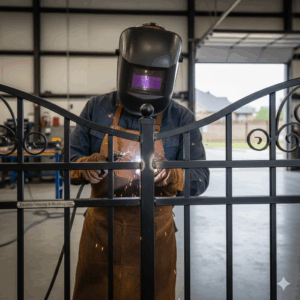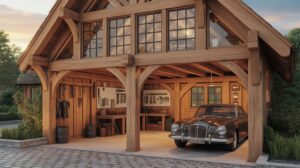The shoreline is now not simply an area of natural beauty—it’s a canvas for lifestyle enhancement. As waterfront property proprietors are trying to find both characteristic and aesthetic, custom boat houses have emerged as standout features. These structures, initially utilitarian, are being reimagined with current substances, current designs, and sustainable methods. Thanks to advancements in marine production, building better boat homes is no longer a dream—it’s a dynamic reality. Below, we discover how innovation is reworking the future of custom boat house layout and production, from materials and green features to technology integration and architectural finesse.
Reimagining Functionality: From Storage to Lifestyle Spaces
Custom boat homes have evolved a long way beyond a fundamental watercraft garage. Today’s designs combine lounges, rooftop decks, guest quarters, and entertainment regions, turning once-simple structures into high-priced extensions of the home. The shift in characteristic is riding an entire rethinking of form. Innovative marine builders are designing with multipurpose capability in mind. Durable floating docks allow for growing and falling water stages, while retractable doorways, open-air lounges, and wet bars bring in an inn-like sense. Structural engineers are also factoring in wind resistance and seasonal changes, ensuring that boat homes aren’t just stunning but resilient. This evolution reflects a developing preference amongst homeowners to maximise their waterfront lifestyle. With the right marine production group, what starts as a boathouse can come to be a private waterfront retreat.
Advanced Materials for Strength and Longevity
One of the important challenges in building on water is ensuring durability. Moisture, UV publicity, and salinity can wreak havoc on conventional substances. Today’s custom boat houses are taking advantage of a brand new wave of marine-grade construction merchandise that improves energy, sustainability, and preservation. Composite decking, fiber-reinforced concrete, and dealt with glulam timbers at the moment are popular picks in contemporary boat house tasks. These substances resist rot, pests, and corrosion more than their predecessors. Additionally, smart coatings and finishes are helping shield structural elements from saltwater intrusion. Technological advancements in materials also lessen the long-term price of protection. With less need for replacements and repairs, waterfront owners enjoy peace of mind, knowing their funding will withstand the take a look at of time and tides.
Eco-Friendly Design in Modern Marine Construction
Sustainability is at the forefront of marine production, and custom boat houses are no exception. With the fitness of aquatic ecosystems in mind, builders are embracing environmentally responsible techniques that reduce impact on shoreline habitats. This consists of the usage of eco-friendly materials like recycled plastic lumber, which mimics the appearance of wood without harming forests or contributing to microplastic pollutants. Floating foundations and modular docks may be assembled with minimal seabed disruption. Additionally, integrating functions like solar panels, rainwater collection systems, and electricity-green lighting fixtures complements the boat residence’s self-sufficiency. Eco-conscious design is not only a fashion—it’s turning into an expectation. Homeowners need systems that mirror their values, and marine contractors who include inexperienced construction practices are gaining a facet in nowadays’s marketplace.
Smart Technology Enhancing Waterfront Living
Imagine arriving at your boathouse to discover the lighting on, track gambling, and your boat equipped, all activated remotely. Smart generation is making custom boat homes no longer simply lovely and sturdy, but quite sensible. Wi-Fi-enabled controls, motion sensors, climate control systems, and remote-operated lifts are a few of the brand-new innovations reworking marine systems. These structures can display humidity, temperature, and even detect water intrusion, sending real-time indicators to your cell phone. For protection and comfort, automation is fundamental. Cameras, security lights, and smart locks allow faraway get right of entry and monitoring, which is particularly treasured for 2nd houses or seasonal getaways. Integrating these systems throughout the marine construction section ensures seamless connectivity and disaster-proofing. As clever houses end up the same old, smart boat homes are the next step for tech-savvy waterfront residing.
Architectural Innovation: A Fusion of Form and Environment
Today’s boat houses are not cookie-cutter systems—they are architectural statements that mix harmoniously with their natural surroundings. This is where form meets characteristic in an extraordinary style. Architects and designers are working closely with marine creation specialists to create custom boat homes that mirror the aesthetics of the primary home whilst complementing the coastline. Minimalist, Scandinavian-stimulated lines, massive glass panels for panoramic views, and the use of herbal materials like stone and reclaimed wood provide a continuing mixture of built and herbal environments. Innovative designs also admire the land and water. Elevated systems lessen flood risk whilst maintaining shoreline flora. Thoughtful placement ensures that boat homes do not obstruct views or disrupt neighborhood flora and fauna. The result is a structure that not only best serves a practical motive but also enhances the splendor of the waterfront.
Conclusion: The Future of Custom Boat Houses
As expectations for waterfront residing hold to upward push, the development of custom boat homes has end up an art as tons as a science. With the infusion of new materials, sustainable techniques, smart technology, and architectural elegance, the destiny of marine construction is undeniably exciting. Whether you are envisioning a rustic getaway or a swish present-day retreat, these days’ custom answers make it viable to turn your dream boat residence right into a reality. Innovation isn’t always just improving how we build at the water—it’s raising how we live via it.








